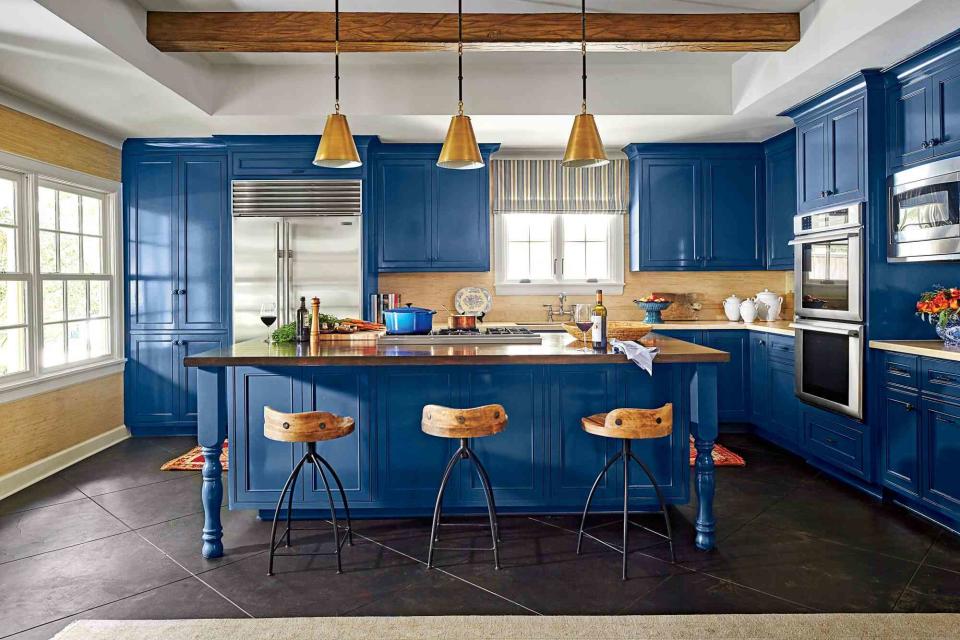How To Clean Your Kitchen Cabinets
Painted cabinets are stylish but might also be too good at hiding grime.

If you can't go to bed with a sink full of dishes and want to know that everything is in place before a good night's sleep, your kitchen's cleanliness is likely essential to you. After cleaning all the dishes, stovetops, countertops, and pans, you should focus on the kitchen cabinets. These often neglected surfaces harbor more dirt than you realize.
After reorganizing your kitchen—big or small—to maximize efficiency, the bigger task of deep scrubbing your cabinets is the next necessary step. As stylish as your navy-blue cabinets might be, they are also good at hiding spills.
Whether your cabinets are wood, laminate, painted, or custom, I'm willing to bet yours could use a scrub too. Here's what you need to know to clean your kitchen cabinets.
How Often To Clean Kitchen Cabinets
If you're in the kitchen often, daily cooking is coating your cabinets with grease and grime, whether you like it or not. To keep things clean, try to wipe the outside of your cabinets once a week. Deep clean the outside and inside every few months.
What You Need:
Microfiber cloth or soft, clean rags
Toothbrush
Bucket
Warm water
Dish soap
Baking soda
Multi-purpose Cleaner
Kitchen gloves
Handheld vacuum cleaner (optional)
Soft cleaning eraser (optional)
Oil cleaner (for wood cabinets only)
How To Clean Painted Kitchen Cabinets
Let's start with painted cabinets. This Better Homes and Gardens article can be a jumping-off point. Tailor the process to fit your space as needed.
Clear the Way: It might seem daunting, but do it. For deep cleaning, it's best to start with empty shelves. Clear your dishes, cups, and appliances from the cabinets. Tip: Time this cleaning with a full dishwasher to make it easier.
Pick the Right Cloth: Painted cabinets are sensitive, so avoiding abrasive cleaning tools is best. A soft cloth or clean rag will do the trick. Try using a microfiber cloth.
Clean the Exterior: Grabbing a typical multi-purpose bottle with all the sprays stashed under the sink is tempting, but leaning on the research, mix warm water with a bit of dish soap to create a nice bubble bath for the painted exterior of the cabinets.
Wipe the Outside of Each Cabinet. Start from the top and work your way down. Avoid getting the cabinets too wet since a damp cloth is best for drying painted cabinet areas. If you want to try an all-purpose cleaner, test it on an inconspicuous spot before making a wipe you may regret.
Spot Clean Grease: After a full round on your cabinets, find and remove grease stains. To remove, mix two parts baking soda with one part warm water and rub the paste onto the remaining stains. Let it sit before wiping it away with a damp cloth and patting it dry.
Vacuum the Inside: It's incredible where crumbs can end up. A handheld vacuum was a quick solution for stray crumbs.
Wipe Down Shelves: After testing a multi-purpose cleanser on an out-of-site spot, wipe down each empty shelf, working cabinet by cabinet. Be sure to wipe dry before moving on.
Scrub the Nooks and Crannies: Gently scrub the corners and crevasses inside each cabinet using an old toothbrush.
Give It a Final Dry and Replenish Shelves: Before putting all your dishes away (a much-needed opportunity to reorganize the shelves!), wipe down everything and ensure all surfaces are dry.
Tips For Wooden And Laminate Cabinets
While a few things vary by cabinet type, most of the process translates to wooden or laminate cabinets. Here are a few things to remember about cleaning other kinds of cabinets.
Wood Cabinets
Like painted cabinets, wooden cabinets need gentle cleaners. Use oil soap to clean and polish your cabinets with a microfiber cloth. Use damp cloths and wipe with the grain. Dilute oil soap with warm water and use a toothbrush to spot-treat stains.
Laminate Cabinets
All-purpose cleaners work fine on this hardier surface: mix baking soda and warm water for spot cleaning, similar to painted cabinets. You can also use a soft cleaning eraser to remove scuff marks on laminate cabinets.
Tips To Keep Your Kitchen Cabinets Clean Longer
Keep your kitchen cabinets looking new and shiny by maintaining a clean space. Despite daily use, kitchen cabinetry can remain new-like in its appearance while still conveniently storing everything you need.
Avoid Water Exposure
One way to keep kitchen cabinets clean is to avoid water exposure. Don't let the water settle in the hinges or surround the hardware. Use a microfiber cloth to ensure the area is dry entirely when cleaning.
Use Gently Cleaning Solutions
When cleaning kitchen cabinets, you want to avoid using cleaning products with harsh chemicals because you can accidentally strip the varnish or finish on laminate, wood, or painted items. Try using a diluted solution of baking soda and water or dishwasher soap and water. Remember to dry completely.
For more Southern Living news, make sure to sign up for our newsletter!
Read the original article on Southern Living.

